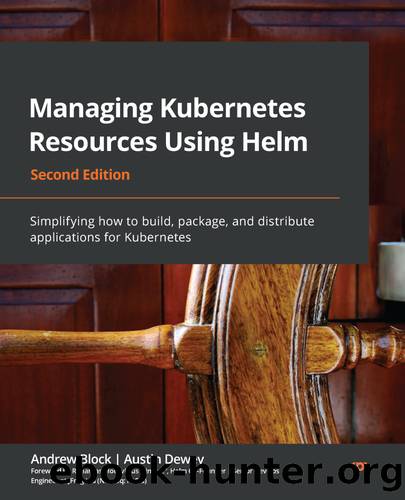Managing Kubernetes Resources Using Helm Second Edition by Andrew Block | Austin Dewey

Author:Andrew Block | Austin Dewey
Language: eng
Format: epub
Publisher: Packt Publishing Pvt Ltd
Published: 2022-09-09T00:00:00+00:00
There are occasions where portions of a template would need to be included or excluded based on some sort of condition. In this situation, an if/else action can be used. Here is a basic example for conditionally determining whether to include a readiness probe as part of a deployment resource:
{{- if .Values.readinessProbe.enabled }} readinessProbe: httpGet: path: /healthz port: 8080 scheme: HTTP initialDelaySeconds: 30 periodSeconds: 10 {{- end }}
The readinessProbe section will only be included when the condition evaluates to true. However, it is important to note that the condition is actually a pipeline where multiple statements can be chained together to aid in the creation of complex conditionals. The logic behind the if/else action can also be interpreted as follows:
{{ if PIPELINE }} # Do something {{ else if OTHER PIPELINE }} # Do something else {{ else }} # Default case {{ end }}
The conditional statements and their associated if/else action should look familiar to anyone with prior programming experience. But what is the logic behind determining whether a pipeline is true or false?
A pipeline fails to evaluate to true when the following is returned:
A false Boolean
A numeric 0
An empty string
nil (whether it be empty or null)
An empty collection
Download
This site does not store any files on its server. We only index and link to content provided by other sites. Please contact the content providers to delete copyright contents if any and email us, we'll remove relevant links or contents immediately.
| Disaster & Recovery | Email Administration |
| Linux & UNIX Administration | Storage & Retrieval |
| Windows Administration |
Kotlin in Action by Dmitry Jemerov(17185)
Grails in Action by Glen Smith Peter Ledbrook(15390)
Sass and Compass in Action by Wynn Netherland Nathan Weizenbaum Chris Eppstein Brandon Mathis(13266)
Azure Containers Explained by Wesley Haakman & Richard Hooper(7499)
Configuring Windows Server Hybrid Advanced Services Exam Ref AZ-801 by Chris Gill(7496)
Running Windows Containers on AWS by Marcio Morales(7053)
Microsoft 365 Identity and Services Exam Guide MS-100 by Aaron Guilmette(5435)
Microsoft Cybersecurity Architect Exam Ref SC-100 by Dwayne Natwick(5272)
Combating Crime on the Dark Web by Nearchos Nearchou(5018)
The Ruby Workshop by Akshat Paul Peter Philips Dániel Szabó and Cheyne Wallace(4701)
Management Strategies for the Cloud Revolution: How Cloud Computing Is Transforming Business and Why You Can't Afford to Be Left Behind by Charles Babcock(4546)
Python for Security and Networking - Third Edition by José Manuel Ortega(4274)
The Age of Surveillance Capitalism by Shoshana Zuboff(4247)
Learn Wireshark by Lisa Bock(4176)
Learn Windows PowerShell in a Month of Lunches by Don Jones(4069)
The Ultimate Docker Container Book by Schenker Gabriel N.;(3920)
Ember.js in Action by Joachim Haagen Skeie(3661)
DevSecOps in Practice with VMware Tanzu by Parth Pandit & Robert Hardt(3611)
Windows Ransomware Detection and Protection by Marius Sandbu(3577)
